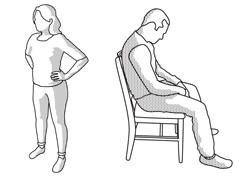Can striking the proper pose put you in good standing for the rest of your life? Our Cover Story is reported now by Rita Braver:
Forty-three-year-old psychologist Amy Cuddy is an Internet sensation.
It all began when she was tapped to give a prestigious TED Talk in 2012. "We make sweeping judgments and inferences from body language, and those judgments can predict really meaningful life outcomes, like who we hire or promote, who we ask out on a date."
And Cuddy notes, "When you pretend to be powerful, you are more likely to actually feel powerful."
Using images of everyone from Oprah and Mick Jagger to world leaders and athletes, she talked about the relationship between posture and power. "So what is your body language communicating to me? What's mine communicating to you?"
But, she says, it's more than how you appear publicly. Believe it or not, her studies show that if you stand like a superhero privately before going into a stressful situation, there will actually be hormonal changes in your body chemistry that cause you to be more confident and in-command. "Before you go into the next stressful evaluative situation, for two minutes try doing this in the elevator, in a bathroom stall, at your desk, behind closed doors -- that's what you want to do," she said.
Her TED Talk has been viewed more than 30 million times, with "power posing" popping up on television shows like "Grey's Anatomy."
But make no mistake, Cuddy's work is grounded in science. As a Harvard Business School professor, she's conducted a series of experiments like the one she demonstrated for us: student volunteers stand in a "power pose," or hunch over in a "powerless pose" for a minute, before putting a golf ball. Early results indicate that, for both men and women, the first putt is closer to the hole after the power pose.
"When you do the opposite, when you act like a scared animal by slouching and collapsing inward, you perform worse," Cuddy said.

In her new book, "Presence," Cuddy writes about how your body can influence your mind, presenting a whole series of poses that can help people feel powerful. Like the "CEO Pose": "Lean back, and open your shoulders," she instructed.
"I hope this doesn't mean that I have to fire a lot of people," said Braver.
U.S. presidents have struck a similar pose while sitting in the Oval Office.
David Gergen, who has worked for four presidents and now teaches at Harvard's Kennedy School of Government, has brought Cuddy in to share her theories with his students.
"I thought she was on to some things," he said. "We don't verbalize it, we don't write about it so much, but we notice it."
"We don't learn this stuff in school," Braver said.
"No, we don't teach it, but you notice it if you are in the arena; you see it all the time," Gergen said.
He talked about working in the White House for Richard Nixon, who prepared himself before a Cabinet meeting: "Throw his shoulders back, put a big grin on his face and walk in -- boy, I'm ready for the world!
"Ronald Reagan had a lot of that -- his bearing made a big difference in how people thought of him; he walked John Wayne-like. Those things make a difference, and I thought Amy was on to some things that just weren't in the research."
It made a difference in Cuddy's own life in 2011, when friends put her in touch with a man doing his own power pose.
It was a pose that Cuddy compared to that which wild animals looking for a mate actually strike: "It does resemble, you might have noticed, a peacock with its tail feathers spread," she told Braver.
"So you thought he was searching?"
"I'm not immune to the effects that I talk about, so I think I fell for it," Cuddy laughed.